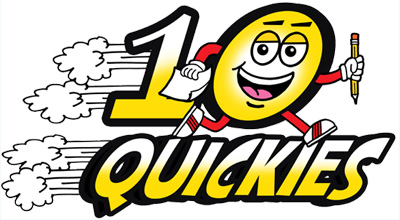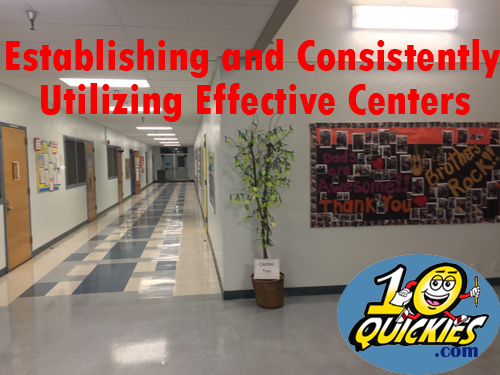Education Articles for Effective Teaching Strategies |
 |
  Establishing and Consistently Utilizing Effective Centers Article Summary: Effective teaching strategies put to great use with classroom centers. Centers can bring an entirely new dynamic to your class. In order to establish and maintain centers in your classroom you will need to carefully plan and organize therefore use these effective teaching strategies to get your classroom centers up and running. ------ Establishing and Consistently Utilizing Effective Centers by Gregory L. Gomez Centers can bring an entirely new dynamic to your class if implemented correctly. Centers can provide an opportunity for students to move from their seats where they likely sit for the majority of the day, and immerse themselves in an engaging and stimulating activity. In order to establish and maintain effective centers in your classroom you will have to carefully plan and organize. The centers you start with should be topics or standards you have had success teaching or are very passionate about. It is important when you begin to design centers in your room, start with just 2 or 3 that you have a strong, personal interest in, or your area of teaching strength. In other words, if you have difficulty teaching science, or have never taught that subject before, stay away from creating a science center for now. At least until you have implemented a few strong ones that function well with your class. Have fun with the center names too! Instead of having the "Writing Center", call it the "Writing Wizards Center" or the "Magic of Writing". Much more stimulating and intriguing don't you think? Instead of the "Math Center", you can name it "Mountain Math" or the "Math Train Station". Having catchy names not only makes the center more kid-friendly, but also gives you plenty of decorating ideas you can build off of. The Writing Wizards Center area can be designed with a magical theme with wands, magician's hats, and magical words like Presto or Abracadabra. The Math Train Station can have related decor such as locomotives, a caboose, train tracks, and of course related words like Choo Choo and All Aboard! Now the ideas become limitless! Once you have a specific number and names of the centers you want to have, it helps to sketch out the layout of your classroom to determine where the ideal places to put them will be. If possible, try and establish centers in a cozy corner of the room or in a place where students feel as though they've temporarily escaped the usual. Try and make the center as decorative, colorful, and eye-catching as possible. The students should be eager to get into the center and complete the activities you have for them. Build off the center name, get creative and have fun. It's also very important to have some type of storage system in place using boxes, buckets, trays, bins, anything so that all the supplies needed for the activities for each center will be clearly stored and labeled for students to access. This helps limit confusion and also gives a specific location where the students need to return everything when it's time to cleanup. Organization of all the materials for each center is imperative for success. Centers Are Established, Now What? =========================== Once you have all your centers set up, it's time to plan how they will be actually used in your classroom. There's no right or wrong way on how to implement centers. It will depend entirely on your preferences and the students you have for this particular year. Your useful teaching strategies definitely come in handy here. Here are some key management points to keep in mind. How will the students access centers in predesigned groups/teams or individually? When will you have centers time and on what days? Will you have a system in place to keep track of their progress? It can be difficult if you have 30 students in your class for them to all use centers at the same time. That might not be realistic or even feasible especially if you are starting off with only two or three centers. One option that can be very effective is having two, thirty minute time blocks where half the class is in centers and the other half in a small instructional group with you. This will give you an opportunity to work with a smaller group of students to focus on a standard/topic they may need help with, while the other half of the class is immersed in your centers. Don't worry if you do not have enough time during the day to run two separate groups of centers. You can simply have one group use the centers one day, and the other group on the following day. Teaching Strategies: Explicitly Teach Students Procedures ========================================= Before the students begin using your newly designed centers, they need to be explicitly taught how they are to use them. Teach them every single component even down to transitioning to and from the centers. This is one of the most crucial steps you shouldn't overlook. Do not under any circumstances take for granted the students will know how to use a center. This can be the difference of what makes your centers successful or what makes them an absolute nightmare. Here are some questions you need to know the answers to before you start using centers: 1) How do students know which center to go to on any given day? 2) What are their center teams or partners? 3) Where do they put the completed center activity when finished? 4) What if they finish the activity before center time is over? 5) Is there a tracking method you have in place so that students get an opportunity to work in each center throughout the week(s)? 6) What is the signal for centers to commence and end? 7) What is the appropriate level of noise when working in centers? **** MOST Important Teaching Strategy - Make sure you make an activity checklist for each center. This checklist should include a step-by-step sequence of what they should do while there for the allotted time. The instructions should be basic enough to where they will not get confused and need to ask you for something. Afterwards - Reflection Time ======================== Take time to reflect on the centers experience especially when you're starting out. How did it go? What were the positives? What were some things that need fine tuning? Small problems can quickly grow into large ones so don't ignore the warning signs you possibly witnessed. How did the groups of students interact within the center? Was there anything that was confusing for the students? How was the noise level? Wherever you see a potential issue, that should immediately raise a red flag. That means you need to address this before centers are used again. Maybe students were just too loud in the center. Reteach appropriate center communication/noise level. You may possibly need to create center rules and consequences if students are having difficulty maintaining themselves per your expectations. Maybe students finished their center activity early and started interrupting your group. Review their center activity checklist and remind the class that even when they finish an activity that does not give them permission to stray from the checklist or start disturbing you. You may even want to assign a reliable student(s) to be in charge of the center as a monitor, helper, and custodian to relieve you of the worry should it arise. Closing ====== Even though it does take a fair amount of planning and preparation on your part to establish effective centers in your classroom, the benefits will be immense in the long run. Not only will your students gain from the learning experience but you will have a valuable small group instructional opportunity that can help struggling students. Don't feel overwhelmed when establishing centers and creating the activities. Take it step-by-step, a little at a time. There is no award for finishing all your centers in a week. Don't burn yourself out. The more time you take to carefully plan, organize, and decorate your centers, the more in tune you will be with their functionality and their effectiveness with your students. Best wishes on your classroom centers journey! --- Gregory L. Gomez, M. Ed, has been teaching 5th grade in the Los Angeles Unified School District for 16 years. He created 10Quickies.com to help teachers and parents provide children in grades 2-5 with a fun and inspirational way to review math standards and concepts. Get valuable teaching strategies along with 4 FREE math worksheets to download just for stopping by. We hope you found this article informative and that you'll be able to take some of the ideas and incorporate them into your classroom. We invite you to take a moment to download four FREE math review worksheets that students have found to be fun and exciting. These aren't the typical worksheets that you've seen before, so don't be surprised if you find your students begging for more 10 QUICKIES! |

